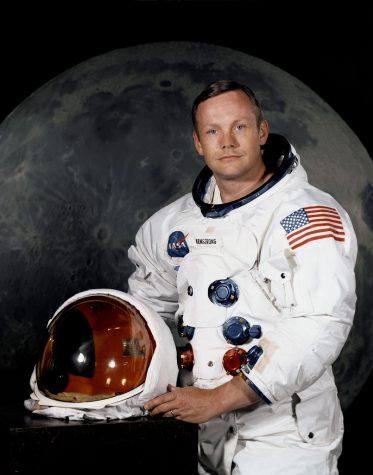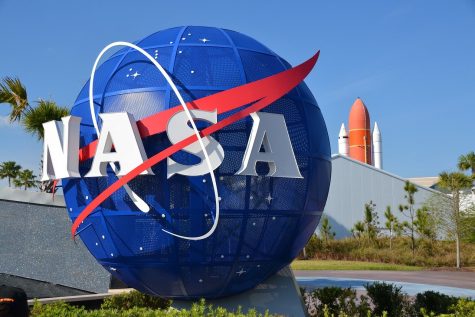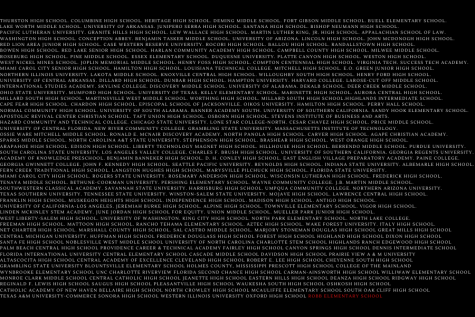Was the moon landing faked?
Created by Magdalen Brands on Canva under Creative Commons license
Picture of a step taken on the moon with the quote on the news from Neil Armstrong

After the work of thousands of employees at NASA, on the 21st of July, 1969 at 02:56 GMT Neil Armstrong became the first US American astronaut to walk on the moon. However, even after the work of over 40,000 employees, it only took one man, Bill Kaysing, to put it all into questions for years to come.
Bill Kaysing, American writer, is believed to be the founder of the fake moon landing conspiracy. This conspiracy claims that the US didn’t actually land on the moon but faked it in order to “prove” how powerful the nation is. According to ex chief historian of NASA, Roger Launius, this thinking quickly exploded into popularity due to the internet. The chief historian also suspects that it is because Americans and many others just simply love conspiracy theories as for each one there is a long counter-explanation.
Kaysing’s statements about the moon landing began when he would write about it and give statements to places like Wired. Along with what he stated was compelling evidence which proved it. Despite having actually contributed to the NASA program between 1956 and 1963, according to The Guardian, Kaysing had plenty to say about the organization.
One things Kaysing told people who would ask about his theories was, “It’s well documented that NASA was often badly managed and had poor quality control, but as of 1969, we could suddenly perform manned flight upon manned flight? With complete success? It’s just against all statistical odds.”
Which was partly true that NASA has difficulties with its organization in the beginning. With Neil Armstrong stating himself that it was easier to walk on the moon than to get there.
Kaysing relied on photocopied samizdat, a way of secretly copying and distributing literature and documents, to inform the world about his suspicions which had three main pieces of evidence that he claimed proved the moon landing was faked. He claimed that the fact that no stars were visible in footage, the lack of a crater under the landing module, and how weirdly the shadows fell were all evidence that the landing was faked. Which could have been convincing until it was paired up against evidence, likes rocks being brought back, and how difficult it would be to keep such a secret from the populace of the world.
This is especially difficult when considering the staggering amount of employees, over 40,000, with yet no employee coming out to confirm Kaysing’s findings yet. A person would also have to rationalize the fact that NASA, while it may be confusing how they had the technology to put a man on the moon, could have not had all the expensive and for the time futuristic technology needed to fake the landing. This has been proven by people and shows like “Adam ruins everything” that there was no way that NASA could have had the technology, lights, cameras, etc, to fake the moon landing. Lastly, it would have been impossible for no one out of the near 600 million watchers to not have noticed something off about the footage of the landing.

This conspiracy theory would enter the modern era when Fox news presented the documentary, “Did we land on the Moon?” This film would repackage Kaysing’s arguments for a new audience. Chief Launius answered questions about NASA’s response by stating that for years NASA saw no reason to respond to such theories or give it any time to hear until the documentary came out because they would get tons of questions afterwards. Including parents and teachers concerned what to tell their kids when they saw it. Leading them to finally respond by giving out educational material.
Though some like author Olive Morton believe that hoaxes like this are not surprising, according to The Guardian. The point he says was to prove how good the US was getting at people to believe something that wasn’t actually true and was more fueled out of anger. This was because after the landing, the saying, “If we can put a man on the moon, why can’t we do x” became popular so when x things didn’t happen, the moon conspiracy gained a foothold. However in modern in era it is also believe to be out of boredom and a fun rabbit hole for people to go down into.
And while the conspiracy has been debunked widely, the fake moon landing conspiracy continues to this day to be one of the most famous.

Hello, my name is Maggie Brands. I'm a senior. I'm new here so I'm excited to see what will happen in this class and what we do here. I enjoy reading and...














